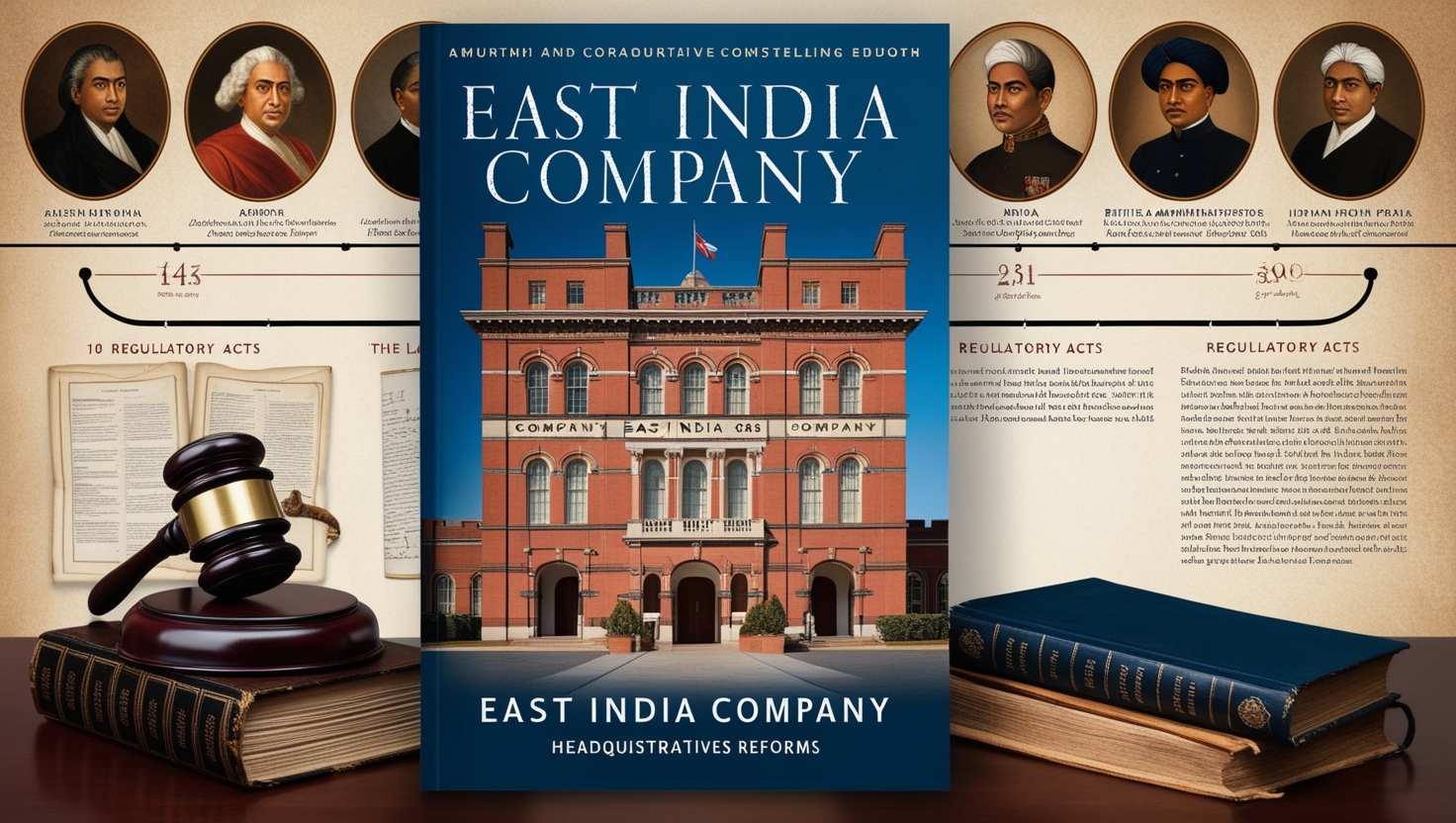
1. Which act was introduced by the British government to address the shortcomings of the East India Company?
- Pitt’s India Act
- British Union Act
- 1707 Act of Union
- India Act 1784
Show Answer
Answer: Pitt’s India Act
Pitt’s India Act of 1784, also known as the East India Company Act 1784, was enacted in the British Parliament to address the shortcomings of the Regulating Act of 1773. It established a system of dual control in India, with authority shared between the British Crown and the British East India Company. The act separated the company’s political functions from its commercial activities, marking the first time such a distinction was made.
2. Which among the following was the first attempt to regulate the affairs of the English East India Company in India?
- Pitt’s India Act 1784
- Charter Act 1833
- The Regulating Act 1773
- Charter Act of 1813
Show Answer
Answer: The Regulating Act 1773
The Regulating Act of 1773 was a significant milestone in the constitutional development of India. It was the first instance of direct involvement by the British Parliament in Indian affairs. Lord North was the Prime Minister of England when the Regulating Act was passed.
3. The dual government introduced by Pitt’s India Act continued to operate in India until it was abolished by which of the following laws?
- Government of India Act 1858
- Charter Act 1853
- Indian Councils Act 1861
- Indian Councils Act 1909
Show Answer
Answer: Government of India Act 1858
The Government of India Act 1858 initiated a new era in India’s constitutional history. This act led to the dissolution of the East India Company and the transfer of powers, territories, and revenues to the British Crown. It effectively ended the dual government established by Pitt’s India Act, paving the way for direct governance of India by the British Crown.
4. Which of the following Governor-Generals was impeached for charges of corruption?
- Earl Cornwallis
- Warren Hastings
- Lord Mayo
- Lord Minto
Show Answer
Answer: Warren Hastings
Warren Hastings, during his time as Governor-General of India, faced impeachment in the House of Commons on charges of embezzlement, extortion, and the alleged wrongful execution of Maharaja Nandakumar. He was eventually replaced by Lord Cornwallis.
5. With reference to the “Board of Control” in the East India Company, consider the following statements:
- It was formed by Pitt’s India Act of 1784.
- It controlled the commercial matters of the company.
- It was abolished by the Government of India Act 1858.
Choose the correct code
- Only 1 is correct
- Only 1 & 2 are correct
- 1 & 3 are correct
- 1, 2 & 3 are correct
Show Answer
Answer: 1 & 3 are correct
Pitt’s India Act of 1784 introduced the Board of Control to increase the British Crown’s oversight of the East India Company’s administration in India. This board had authority over all matters related to the civil and military governance and the revenues of the company’s officers in India. The Board of Control was abolished by the Government of India Act 1858 when the governance of India was transferred to the British Crown.
6.
Which of the following is/are correct statements about the Charter Act of 1813?
- It ended the monopoly of the East India Company to trade in tea.
- It made the Governor-General of Bengal the Governor-General of British India.
- It also had a provision for the Company to invest Rs. 1 Lakh every year on the education of Indians.
Choose the correct code
- 3 Only
- 2 and 3 Only
- 1, 2, and 3
- Neither 1 nor 2
Show Answer
Answer: 3 Only
The Charter Act of 1813 did not completely end the East India Company’s monopoly on trade in tea. The monopoly remained intact for tea and trade with China, although private traders were allowed to engage in such activities under special licenses. Additionally, the act stipulated that the Company should invest a fixed sum of Rs. 1 Lakh annually in the education of Indians.
7. Which of the following statements is/are correct about the Regulating Act, 1773?
- The Regulating Act of 1773 was the first act that aimed to bring the administration of the East India Company under the control of the British Parliament and Crown.
- It separated the commercial and political activities of the British East India Company.
- The act led to the establishment of the Supreme Court at Calcutta, and it provided for the appointment of a Board of Control for joint government of British India by the Company and the Crown.
- 1 & 2 Only
- 3 Only
- 2 & 3 Only
- 1, 2 & 3 are correct
Show Answer
Answer:1, 2 & 3 are correct
The Regulating Act of 1773 aimed to bring the administration of the East India Company under the control of the British Parliament and Crown. It resulted in the separation of the company’s commercial and political functions, the establishment of the Supreme Court in Calcutta, and the creation of a Board of Control to facilitate joint governance of British India by the Company and the Crown.
8. Which of the following is/are correct statements about the Charter Act of 1833?
- It renewed the East India Company’s privileges for another twenty years.
- It ended the monopoly of the East India Company to trade with China.
- 1 Only
- 2 Only
- Both 1 & 2
- Neither 1 nor 2
Show Answer
Answer: Both 1 & 2
Both statements are accurate regarding the Charter Act of 1833. It renewed the East India Company’s privileges for another two decades, except for the trade in tea and opium with China, which it opened up to private traders under special licenses.
9.
Which of the following statements are correct about the Pitt’s India Act of 1784?
- 1. It separated the commercial and
political activities of the British East
India Company - 2. The members of Governor General’s
council were reduced from four to
three - 3. The act advocated non intervention
of company in India’s internal
Affairs
Choose the right code
- 1 & 2 Only
- 3 Only
- 2 & 3 Only
- 1, 2 & 3 are correct
Show Answer
Answer: 1 & 2 Only
Pitt’s India Act of 1784 aimed to increase the British Crown’s control over the administration of the East India Company in India. While it separated the company’s commercial and political activities, it did not advocate non-intervention of the company in India’s internal affairs.
10. How many members were there in the Governor General’s Council constituted in 1773?
- 3
- 4
- 5
- 6
Show Answer
Answer: 4
The Governor-General’s Council established by the Regulating Act of 1773 consisted of four members.
Q11: Which of the following Acts reduced the power of the Supreme Court, which was constituted as per the Regulating Act 1773?
1. The Act of 1775
2. The Act of 1778
3. The Act of 1781
4. The Act of 1784
Show Answer
Answer: 3
Explanation: The Judicature Act of 1781 was enacted to address the deficiencies in the Regulating Act of 1773 and to resolve conflicts between the Supreme Court and the Court of the Company. This act limited the power of the Supreme Court.
Q12: Which of the following Acts was/were passed during the reign of Warren Hastings?
1. Regulating Act of 1773
2. Act of Settlement 1781
3. Pitt’s India Act 1784
4. Charter Act of 1813
Choose the right code
1. 1 only
2. 1 & 3
3. 1, 2 & 3
4. 1, 2, 3 & 4
Show Answer
Answer: 3
Explanation: The acts passed during the tenure of Warren Hastings included the Regulating Act of 1773, the Act of Settlement 1781, and Pitt’s India Act 1784.
Q13: Which of the following acts is also known as the Saint Helena Act?
1. Charter Act of 1813
2. Charter Act of 1833
3. Charter Act of 1853
4. Government of India Act of 1858
Show Answer
Answer: 2
Explanation: The Charter Act of 1833, often referred to as the Saint Helena Act, designated the Governor-General of Bengal as the Governor-General of India.
Q14: As per the Regulating Act of 1773, what was the fixed number of the Court of Directors?
1. 10
2. 15
3. 20
4. 24
Show Answer
Answer: 4
Explanation: As per the Regulating Act of 1773, the Court of Directors had 24 members, with one-fourth of them retiring annually, and their tenure was fixed for four years.
Q15: Who among the following were the judges of the Supreme Court established by the Regulating Act of 1773?
1. Sir Elijah Impey
2. Stephen Caesar Le Maistre
3. Robert Chambers
4. Justice Hyde
Choose the right code
1. 1 only
2. 1 & 3
3. 1, 2 & 4
4. 1, 2, 3 & 4
Show Answer
Answer: 4
Explanation: The Regulating Act of 1773 established the Supreme Court in Calcutta, with Sir Elijah Impey as its first Chief Justice. Three more judges were appointed to oversee both civil and criminal cases.
Q16: Which among the following were the provisions of the Regulating Act of 1773?
1. The Bengal presidency got superiority over Bombay and Madras presidency.
2. The Governor-General may work under his own discretion.
3. Empowering the Governor-General to hold the office of Commander-in-Chief.
4. Restoration of the territory of Zamindars who were affected by the quinquennial settlements.
Choose the right code
1. 1 & 3
2. 2 & 4
3. 1, 2 & 4
4. 1, 2, 3 & 4
Show Answer
Explanation: The Regulating Act of 1773 included several provisions, such as giving precedence to the Bengal presidency over Bombay and Madras, granting discretionary powers to the Governor-General, allowing the Governor-General to hold the office of Commander-in-Chief, and restoring the territory of Zamindars affected by the quinquennial settlements.
Q17: Who among the following were the members of the Governor-General’s council of Warren Hastings?
1. John Clavering
2. George Monson
3. Philip Francis
4. Richard Barewell
Choose the right code
1. 1 & 2
2. 2 & 4
3. 1, 3 & 4
4. 1, 2, 3 & 4
Show Answer
Answer: 4
Explanation: Warren Hastings was appointed as the first Governor-General of Bengal, with his council comprising four members: John Clavering, George Monson, Philip Francis, and Richard Barewell.
Q18: Which of the following acts was passed to nullify the shortcomings of the Regulating Act of 1773?
1. Judicature Act of 1781
2. Act V of 1834
3. Indian Council Act of 1784
4. Charter Act of 1813
Show Answer
Answer: 1
Explanation: The right answer is judicature Act of 1781
Explanation: The Judicature Act of 1781 was introduced to nullify the shortcomings of the Regulating Act of 1773 and settle the conflict between the Supreme Court and the Governor-General in Council.
Q19: Which among the following recommendations of the Fox India Bill is/are correct?
1. Abolition of the Court of Directors and the Court of Proprietors.
2. Seven Commissioners or Directors would take care of the administration and revenue.
3. After the dismissal of all persons in the service of the Company, vacancies were to be filled by the Crown.
Choose the right code
1. 1 only
2. 1 & 2
3. 1 & 3
4. 1, 2 & 3
Show Answer
Answer: 4
Explanation: The Fox India Bill proposed the abolition of the Court of Directors and the Court of Proprietors. It recommended the appointment of seven Commissioners or Directors to oversee the administration and revenue, with vacancies to be filled by the Crown following the dismissal of all Company personnel.
Q20: Which among the following about the Pitt’s India Act is/are correct?
1. It established the Board of Control consisting of six members.
2. The member of the Governor-General’s council was reduced to three.
3. The Court of Directors was given the right to make appointments of the servants.
4. It declared that no pardon should be granted to official offenders.
1. 2 & 4
2. 1, 2 & 3
3. 1, 3 & 4
4. 1, 2, 3 & 4
Show Answer
Answer: 2
Explanation: The Pitt’s India Act established the Board of Control consisting of six members. It also reduced the member of the Governor-General’s council to three. Additionally, the Court of Directors was given the right to make appointments of the servants. However, the act did not have a provision that no pardon should be granted to official offenders.
Q21: Which of the following act established a system of double government?
1. Regulating Act of 1773
2. Charter Act of 1813
3. Pitt’s India Act of 1784
4. Charter Act of 1833
Show Answer
Answer: 3
Explanation: Pitt’s India Act of 1784 established a system of double government, with the Court of Directors managing commercial affairs and the Board of Control managing political affairs.
Q22: Which of the following act empowered the British Government with the supreme power to control the affairs and administration of the company?
1. Pitt’s India Act of 1784
2. Charter Act of 1813
3. Charter Act of 1833
4. Regulating Act of 1773
Show Answer
Answer: 1
Explanation: Pitt’s India Act of 1784 vested the British Government with supreme authority over the administration of the East India Company in India.
Q23: Who of the following was appointed as the Commander-in-Chief of the Indian forces by the Act of 1786?
1. Lord Dalhousie
2. Lord Hastings
3. Lord Minto
4. Lord Cornwallis
Show Answer
Answer: 4
Explanation: The Act of 1786 appointed Lord Cornwallis as the Commander-in-Chief of the Indian forces.
Q24: Which among the following about the Charter Act of 1813 are correct?
1. An amount of 1 lakh was provided for the spread of education.
2. Training became mandatory for the servants of the company before service entry.
3. The power of the Board of Control was enlarged.
4. Special provision was made for the cases where Britishers and Indians were involved.
Choose the right code
1. 1 & 4
2. 1, 2 & 3
3. 1, 3 & 4
4. 1, 2, 3 & 4
Show Answer
Answer: 2
Explanation: The correct statements about the Charter Act of 1813 are:
1. An amount of 1 lakh was provided for the spread of education.
2. Training in England became mandatory for the servants of the company before
service entry.
3. The power of the Board of Control was defined and enlarged.
Q25: Which of the following acts was considered as the final step towards centralization in British India?
1. Regulating Act of 1773
2. Charter Act of 1813
3. Charter Act of 1833
4. None of the above
Show Answer
Answer: 3
Explanation: The Charter Act of 1833 was considered a significant step toward centralization in British India.
Q26: The laws made under which of the following act of the Government of India were to be called Acts?
1. Charter Act of 1833
2. Charter Act of 1813
3. Charter Act of 1853
4. Indian Council Act of 1861
Show Answer
Answer: 1
Explanation: The Charter Act (The Saint Helena Act) of 1833 designated the laws made under this act as Acts, replacing the previous term Regulations.
Q27: Which of the following Act ended the recognition and activities of the British East India Company as a commercial body?
1. The Charter Act of 1813
2. The Charter Act of 1853
3. The Charter Act of 1833
4. Pitt’s India Act of 1784
Show Answer
Answer: 3
Explanation: The Charter Act of 1833 brought an end to the British East India Company’s recognition and operations as a commercial entity, transforming it into an administrative body.
Q28: Which of the following acts introduced an open competition system of recruitment in Civil Service?
1. Charter Act of 1813
2. Charter Act of 1833
3. Charter Act of 1853
4. Government of India Act of 1858
Show Answer
Answer: 3
Explanation: The Charter Act of 1853 introduced an open competition system for the recruitment of civil servants in India.
Q29: Which among the following about the Charter Act of 1853 are correct?
1. Legislative and executive functions of the Governor-General’s council were separated.
2. Additional members were appointed to the Governor-General’s council.
3. A separate Lieutenant Governor for Bengal was appointed.
Choose the right code
1. 1 only
2. 1 & 2
3. 2 & 3
4. 1, 2 & 3
Show Answer
Answer: 4
Explanation: The correct statements about the Charter Act of 1853 are:
1. Legislative and executive functions of the Governor-General’s council were separated.
2. Additional members were appointed to the Governor-General’s council, making the total number 12.
3. A separate Lieutenant Governor (Lord Dalhousie) for Bengal was appointed.
Q30: Who presided the first Pre-independence Law Commission?
1. Lord Stanley
2. Lord Macaulay
3. Sir Charles Wood
4. None of the above
Show Answer
Answer: 2
Explanation: The first Pre-independence Law Commission was established in 1834 under the Charter Act of 1833, with Lord Macaulay as its chairman. The first Post-independence Law Commission was instituted in 1955.







